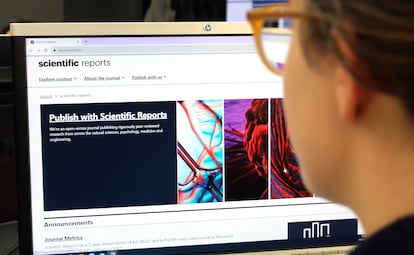Scientists paid large publishers over $1 billion in four years to have their studies published with open access
A study reveals that academic megajournals ‘Scientific Reports’ and ‘Nature Communications’ have cornered the market


For the last half century, scientists have followed the same method to publish their research. For example, a scientist discovers a treatment for cancer, other researchers check that the data is correct, and the final results are published in a study in an academic journal. If it is not published, it is not science. However, in recent years the system has undergone a transformation. It is no longer the readers who pay to read the studies, but the authors themselves who pay for their research to be published in digital journals with open access. Led by German expert Stefanie Haustein, a group of scientists has now calculated the turnover of the “oligopoly” that controls this new market. Using mainly public funds, the scientific community paid the five large publishers $1.06 billion in four years. And according to this estimate, the sum covers only the fees to publish open access studies.
It is a bubble that is about to burst. Since 2021 public institutions that invest in science have required authors to publish their studies with open access. And in evaluations that their salaries, promotions, and research budgets depend on, scientists are judged by the number of studies they have published. This system, known as “publish or perish,” has given rise to a huge business with perverse incentives to produce more and more insubstantial studies; publishers earn more money, and researchers pad their resumes with little to no effort. The most prolific scientist in Spain, José Manuel Lorenzo, head of research at the Meat Technology Center of the Xunta de Galicia, published 176 papers last year. That means he published one study every two days, even on topics unrelated to his field of expertise, such as how hospitals have managed monkeypox.
Stefanie Haustein’s team from the University of Ottawa (Canada) has spent “years” collecting data from the period 2015-2018. According to their calculations, Springer Nature took the lion’s share, with $589.7 million, followed by Elsevier ($221.4 million), Wiley ($114.3 million), Taylor & Francis ($76.8 million), and Sage ($31.6 million). The fees required for a study to be made available with open access are officially called “article processing charges,” and on average, authors or their institutions have to pay more than $2,500 per study. French sociologist Pierre Bataille refers to the publishers’ charges as “research vampirization.”
Haustein’s study reveals that two scientific journals, Scientific Reports and Nature Communications, accounted for this income, with $105.1 million and $71.1 million, respectively. Both belong to the British publisher Springer Nature, of which the Holtzbrinck Group controls 53%. The German family company was founded after the Second World War by repentant Nazi Georg von Holtzbrinck. The British publishing house owns the prestigious weekly journal Nature, as well as 4,600 others. Haustein’s analysis confirms that Scientific Reports and Nature Communications are two megajournals converted into profit-making machines through open access fees. Scientific Reports is the journal that publishes the most studies in the world — almost 22,000 papers last year — and charges $2,490 for each one. Nature Communications publishes about 7,500 articles a year and demands $6,490 for each of them. To be published in Nature, the jewel in the crown of scientific publications, the price is $11,690.
Stefanie Haustein considers it “obscene” that the profit margins of the main publishers “reach between 30% and 40%, well above most industries.” The researcher gives the example of the Dutch giant Elsevier, which last year published 600,000 studies, a quarter of which were open access. Elsevier’s annual income was $3.5 billion, with $1.3 billion in profit, according to its 2022 accounts. “This means that for every $1,000 that the academic community spends on publishing in Elsevier, about $400 go into the pockets of its shareholders,” Haustein explains.
The German researcher points out the paradoxes of the current system. The scientific community pays to publish its own studies and works for publishers reviewing the work of other colleagues for free. To top it off, institutions must still pay annual subscriptions to read journals that are not open access. “This means that the academic community has to pay to access the content they have provided for free. And, on top of that, the general public faces a paywall, when it is often their taxes that finance these studies and their publication. It is an unsustainable model that is depleting research budgets around the world,” says Haustein, who has published her results in the journal of the International Society for Scientometrics and Informetrics.
The author warns that these five large publishers have tripled their number of open access studies since 2018 and have increased their prices, so the current expenditure will be well above $1 billion. In addition, other actors have entered the scene. One of these is the MDPI publishing house. Founded in Switzerland by the Chinese chemist Shu-Kun Lin, the publisher is accused of lowering the bar to increase its income. Approximately one in six Spanish studies have published their studies in MDPI journals. Researcher Lin Zhang, from Wuhan University (China), has calculated that the scientific community of just six countries — the United States, China, the United Kingdom, France, the Netherlands, and Norway — pays over $2 billion each year to a dozen publishers to publish their work with open access.
Susie Winter, a spokeswoman for Springer Nature, considers that the new analysis uses “very outdated” data and “poor” methodology, since it does not take into account discounts and exemptions from publishers, like those intended for scientists in countries that spend less on scientific research. She maintains that “the main reason” for Springer Nature’s higher income is that the group opted for open access before its rivals. The British publisher published almost 85,000 open access studies in 2018, according to its own accounts, compared to 33,000 for Elsevier.
Chemist Luis González, a professor at the Complutense University of Madrid, maintains that the calculation of $1.06 billion in four years is “very little” compared to the current disbursement. The professor has settled his own accounts in Spain. “I started studying this issue because it was costing me a lot of money to publish my results in good journals. Publication costs ate up half of my research budget,” he recalls. González says that Spanish universities and the largest Spanish scientific organization, the CSIC, are going to pay around $120 million between 2021 and 2024 to just three publishers — Elsevier, Wiley, and Springer Nature — to have their studies published with open access.
The professor insists that there are alternatives. In fields such as mathematics and physics, a high percentage of studies are first published in Arxiv, a repository managed by Cornell University (U.S.). “Publishing on Arxiv is completely free for authors. The expenses are about $15 per article and are covered by donations from the university and foundations,” says González. Academic journals usually justify their high rates by having a team of independent experts review the studies before publishing them, but the professor points out that these reviewers do not charge a fee. “We scientists do the review work for Nature and for all journals for free. There is no way to justify the increase in costs. It seems unbelievable that they have foisted this system onto a body of such highly educated people. We are really at a loss,” González laments.
However, the Springer Nature spokeswoman maintains that the new analysis “ignores the costs associated with publishing primary research articles [with original data].” She cites figures handled by James Butcher — former vice president of Springer Nature and now a consultant at the American firm Clarke & Esposito. These figures include 147 editors hired at the Nature Communications magazine, their assistants, computer scientists, lawyers, accountants, publicists, and others. According to Winter, their rates reflect these costs and other costs, such as improvements to their technological platforms.
Haustein responds to criticism. “If publishers believe our estimates are not accurate, we would appreciate it if they would publish their data and be transparent. Their lack of transparency is precisely what has made our work so slow and difficult. Our methodology is solid and very exhaustive, with quite conservative estimates,” the expert explains. Haustein also points out that the real costs of publishing a study range between $200 and $1,000, according to calculations by German expert Alexander Grossmann. “For comparison, Nature Communications charged on average more than $4,000 between 2015 and 2018 and now charges $6,490,” he points out.
Two Spanish researchers fueled the debate in July with an open letter they sent to Nature. The letter was titled: “No-pay publishing: use institutional repositories.” In it Isabel Bernal from the Scientific Information Resources Unit for Research at the CSIC and Pandelis Perakakis from the Complutense explained their alternative model; they would publish in Psicológica, the Spanish Experimental Psychology Society’s flagship publication. Until last year the journal was managed by the German publishing house De Gruyter. Now it is published with open access in CSIC’s institutional repository. The publication costs are around $30 per study.
“Our case shows that it is a feasible model, but there are some missing pieces, such as incentives for academic communities,” says Perakakis. The National Agency for Quality Assessment and Accreditation (ANECA), the Spanish university quality watchdog, has just published a proposal to modify the evaluation criteria for researchers, with the aim of stopping them being judged solely on the number of studies they have had published. The psychologist Pandelis Perakakis considers it “a step in the right direction”, to leave behind “the system of paid journals and easy publication.” The researcher issues a warning: “I fear that, as has already happened in the past, if we do not correctly channel this momentum, the future could be even darker than the present.”
Sign up for our weekly newsletter to get more English-language news coverage from EL PAÍS USA Edition
Tu suscripción se está usando en otro dispositivo
¿Quieres añadir otro usuario a tu suscripción?
Si continúas leyendo en este dispositivo, no se podrá leer en el otro.
FlechaTu suscripción se está usando en otro dispositivo y solo puedes acceder a EL PAÍS desde un dispositivo a la vez.
Si quieres compartir tu cuenta, cambia tu suscripción a la modalidad Premium, así podrás añadir otro usuario. Cada uno accederá con su propia cuenta de email, lo que os permitirá personalizar vuestra experiencia en EL PAÍS.
En el caso de no saber quién está usando tu cuenta, te recomendamos cambiar tu contraseña aquí.
Si decides continuar compartiendo tu cuenta, este mensaje se mostrará en tu dispositivo y en el de la otra persona que está usando tu cuenta de forma indefinida, afectando a tu experiencia de lectura. Puedes consultar aquí los términos y condiciones de la suscripción digital.










































